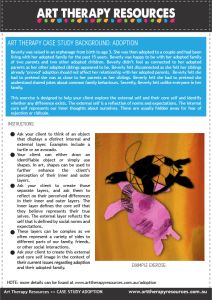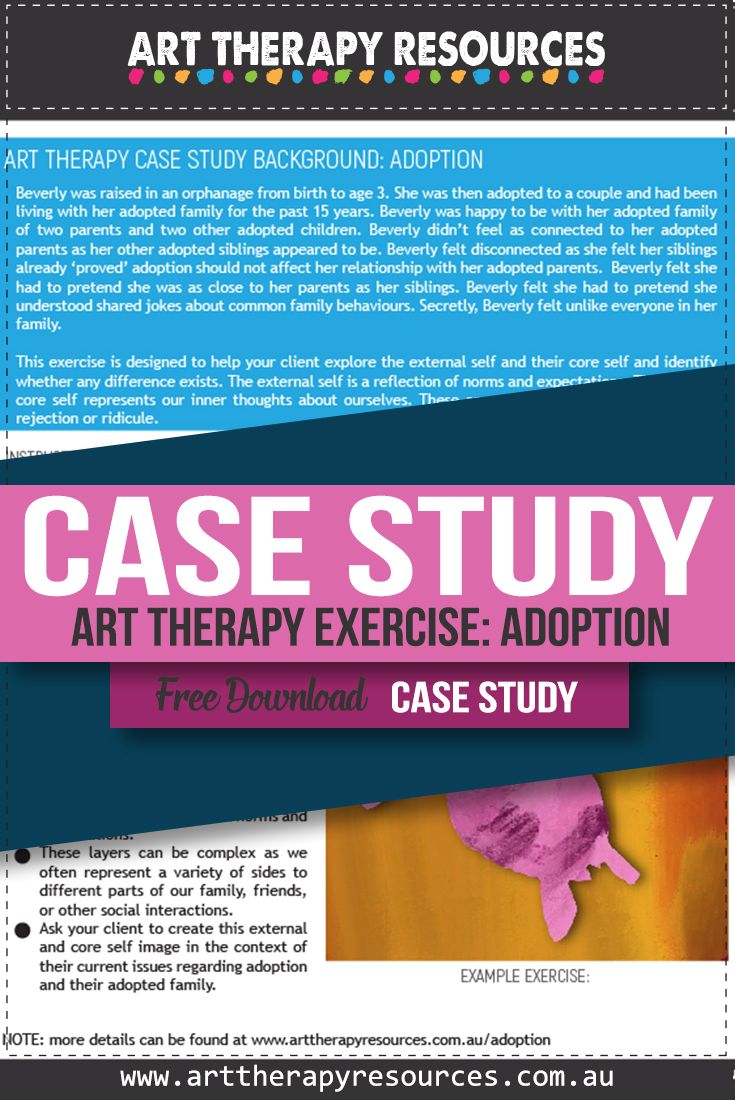THIS POST INCLUDES:
- Art Therapy and Adoption
- About the Client
- Current Client Issues
- Art Therapy Exercise
- Client Insight and Outcomes
- Disclaimer
- FREE DOWNLOAD Art Therapy Exercise
ART THERAPY AND ADOPTION
Adoption is a lifelong experience that affects people differently at various times of their lives. The impact of adoption can vary based on the adoption process, as well as the individual characteristics of the adopted child. Furthermore, the impact of adoption can be influenced by how open the adoptive family is to supporting the emotional journey of the adopted child as they progress through life.
For the adopted child, the impact of adoption is unpredictable. Adopted children may seemingly integrate into their adoptive family throughout childhood, however, when they have their own children, this experience may trigger an enormous rush of emotions about their birth parent’s choices.
THE IMPACT OF ADOPTION
The primary issues that are raised with adoption relate to attachment and bonding. In the 1960s, Bowlby famously linked the interaction of psychoanalytic theory with attachment theory. Bowlby reinforced the belief that the mother/child relationship was integral to survival through the evolutionary process.
Bowlby also reinforced this relationship as integral to the most important components of childhood development through the provision of emotional and physical nurturing. The absence of these components would significantly affect childhood development.
Furthermore, the impact of adoption can extend beyond the baby and birth parents to include the following list:
- Birth and adoptive parents
- Birth and adoptive children
- Birth and adoptive siblings
- Birth and adoptive extended family
- Ongoing intergenerational effects
Historically, researchers have indicated that seven issues have been identified that evolve out of adoption. These are commonly experienced by those who were adopted and include:
1. Loss
2. Rejection
3. Guilt and shame
4. Grief
5. Identity
6. Intimacy
7. Mastery and control
Many issues may stem from adoption, however, the 7 listed above are the core themes that are commonly experienced. As with most experiences in life, an individual will fall along a continuum of personal experience. No two experiences are the same.
Other issues that may arise are:
- Feelings of betrayal
- Assumption of lying and secrecy
- Isolation
- Abandonment
- Low self-esteem
- Conflict with loyalty to family
- Interpersonal relationship issues
- Rejection of cultural differences in adoptive family culture (experienced in international adoptions)
- Isolation from cultural norms in birth culture (experienced in international adoptions)
- Overcompensation to ‘earn’ a place in the family group
HOW ART THERAPY CAN HELP WITH ADOPTION ISSUES
Adoption contains various subconscious conflicts based on the impact of adoption. Art therapy helps integrate personal narratives of the individual so they may overcome these conflicts.
Using creativity to approach these difficult subjects helps the individual process uncomfortable information and emotions they are experiencing. Art can help express the personal stories that each adoptee secretly holds inside.
Through art therapy, the individual is not forced to verbalise how they feel about being adopted. They are not asked to resolve any conflict they might feel about being adopted or the dynamics within their birth or adopted family. The art speaks for the person and allows an unfiltered expression of deeply hidden thoughts and emotions.
Art therapy can help those who are experiencing issues with being adopted by:
- Explore personal identity
- Help families develop bonds through creative work
- Help adoptive families understand the perspective of the adopted child
- Develop emotional regulation
- Coping strategies for stress and distress
- Develop social skills, especially through group work
- Behavioural management
- Reduction of anxiety and depression
- Explore emotions and intrusive thoughts associated with trauma
- Explore attachment in relationships
ABOUT THE CLIENT
- Name: Beverly
- Age: 18
CURRENT CLIENT ISSUES
Beverly was raised in an orphanage from birth to age 3. She was then adopted to a couple and had been living with her adopted family for the past 15 years. Beverly was happy to be with her adopted family of two parents and two other adopted children.
Beverly didn’t feel as connected to her adopted parents as her other adopted siblings appeared to be. Beverly felt disconnected as she felt her siblings already ‘proved’ adoption should not affect her relationship with her adopted parents. Beverly felt she had to pretend she was as close to her parents as her siblings. Beverly felt she had to pretend she understood shared jokes about common family behaviours. Secretly, Beverly felt unlike everyone in her family.
ART THERAPY EXERCISE
This exercise is designed to help your client explore the external self and their core self and identify whether any difference exists. The external self is a reflection of norms and expectations. The internal core self represents our inner thoughts about ourselves. These are usually hidden away for fear of rejection or ridicule.
INSTRUCTIONS:
- Ask your client to think of an object that displays a distinct internal and external layer. Examples include a turtle or an avocado.
- Your client can either draw an identifiable object or simply use shapes. In art, shapes can be used to further enhance the client’s perception of their inner and outer layers.
- Ask your client to create those separate layers, and ask them to reflect on their perceived differences in their inner and outer layers. The inner layer defines the core self that they believe represents their true selves. The external layer reflects the self that is defined by social norms and expectations. These layers can be complex as we often represent a variety of sides to different parts of our family, friends, or other social interactions.
- Ask your client to create this external and core self image in the context of their current issues regarding adoption and their adopted family.
CLIENT INSIGHT AND OUTCOMES
Beverly felt the art exercise was beneficial as it gave her an opportunity to express how she felt a split between what she felt and what she showed to her family. She felt that she could admit that her external view was in contradiction to how she felt.
This understanding gave Beverly insight into the effort she was putting into maintaining a pretence that did not value how she truly felt. Beverly felt she was able to pay attention to her feelings and value them as an important part of her personal adoption story.

DISCLAIMER
This case study represents a snapshot of the client’s progress in treatment. The exercise in this article could be used as written or as a guide for new and original tasks developed by the Art Therapist. Responsibility for treatment resides with the individual therapist who understands their clients specific needs. The art therapy exercise should not be viewed as a pre-defined directive on how to treat a client that presents with a specific range of problems.This art therapy exercise will help build a database of knowledge to draw upon when helping your client. Art Therapy is associated with psychotherapy techniques, however each therapist often approaches therapy with their own foundation of psychological interventions, whether it be psychotherapy, CBT, DBT or other methods.
FREE DOWNLOAD: Art Therapy Exercise
Download the FREE Art Therapy Exercise based on the above Case Study. The free download includes instructions for the art therapy exercise, along with an example of the art therapy exercise.

BUILD YOUR ART THERAPY REFERENCE MATERIALS:
Pin this image to your Pinterest board.

SHARE KNOWLEDGE & PASS IT ON:
If you’ve enjoyed this post, please share it on Facebook, Twitter, Pinterest. Thank you!
